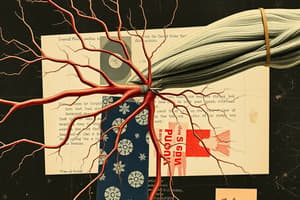Podcast
Questions and Answers
Which structure is located between a nerve fiber and a muscle fiber?
Which structure is located between a nerve fiber and a muscle fiber?
- Motor unit
- Motor pool
- Motor end plate (MEP) (correct)
- Excitation-contraction coupling
What is the main component of the motor pool?
What is the main component of the motor pool?
- Skeletal muscle
- Anterior horn cells (AHCs) (correct)
- Motor end plate (MEP)
- Nerve fibers
What is the main function of the neuromuscular junction (NMJ)?
What is the main function of the neuromuscular junction (NMJ)?
- To transmit electrical signals from the muscle fiber to the motor neuron
- To transmit electrical signals from the motor neuron to the muscle fiber (correct)
- To produce and regulate contractile proteins in the muscle fiber
- To store and release calcium ions for muscle contraction
Which proteins form the contractile proteins in skeletal muscles?
Which proteins form the contractile proteins in skeletal muscles?
What does the motor unit consist of?
What does the motor unit consist of?
What is responsible for transmitting electrical signals from the motor neuron to the muscle fiber?
What is responsible for transmitting electrical signals from the motor neuron to the muscle fiber?
What is the function of Troponin T in muscle contraction?
What is the function of Troponin T in muscle contraction?
During muscle contraction, what leads to the movement of tropomyosin laterally, uncovering the binding sites of actin for the myosin heads?
During muscle contraction, what leads to the movement of tropomyosin laterally, uncovering the binding sites of actin for the myosin heads?
Which structure is responsible for the rapid spread of the action potential in muscle fibers?
Which structure is responsible for the rapid spread of the action potential in muscle fibers?
What is the energy source required for the mechanism of muscle contraction?
What is the energy source required for the mechanism of muscle contraction?
What is the function of troponin I during muscle contraction?
What is the function of troponin I during muscle contraction?
What is the role of myosin heads during muscle contraction?
What is the role of myosin heads during muscle contraction?
Which protein keeps actin structure and covers actin binding sites during muscle contraction?
Which protein keeps actin structure and covers actin binding sites during muscle contraction?
What is the function of troponin C during muscle contraction?
What is the function of troponin C during muscle contraction?
What is the function of sarcotubular system in muscle contraction?
What is the function of sarcotubular system in muscle contraction?
What leads to muscle relaxation during excitation-contraction coupling?
What leads to muscle relaxation during excitation-contraction coupling?
Flashcards are hidden until you start studying
Study Notes
Neuromuscular Junction (NMJ)
- The neuromuscular junction (NMJ) is located between a nerve fiber and a muscle fiber.
- The main function of the NMJ is to transmit electrical signals from the motor neuron to the muscle fiber.
Motor Unit
- The motor unit consists of a motor neuron and all the muscle fibers it innervates.
Muscle Contraction
- Actin and myosin form the contractile proteins in skeletal muscles.
- The motor unit is responsible for transmitting electrical signals from the motor neuron to the muscle fiber.
- During muscle contraction, the binding of calcium to troponin C leads to the movement of tropomyosin laterally, uncovering the binding sites of actin for the myosin heads.
- The myosin heads pull the actin filament towards the center of the sarcomere, causing muscle contraction.
- Tropomyosin keeps the actin structure and covers actin binding sites during muscle contraction, preventing muscle contraction.
Muscle Relaxation
- The troponin I and troponin T complex helps to relax the muscle by blocking the binding of myosin heads to actin.
Muscle Fiber
- The T-tubular system is responsible for the rapid spread of the action potential in muscle fibers.
- The energy source required for the mechanism of muscle contraction is ATP.
Proteins and their Functions
- Troponin T helps to relax the muscle by blocking the binding of myosin heads to actin.
- Troponin I helps to regulate muscle contraction and relaxation.
- Troponin C binds to calcium, leading to muscle contraction.
- Sarcotubular system helps to regulate muscle contraction and relaxation by controlling the release and uptake of calcium ions.
Studying That Suits You
Use AI to generate personalized quizzes and flashcards to suit your learning preferences.




